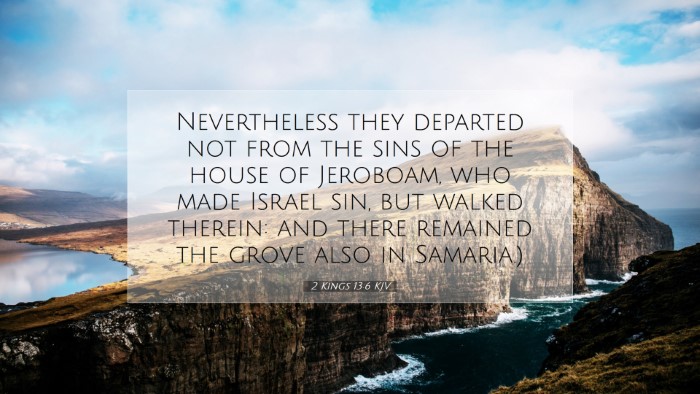Commentary on 2 Kings 13:6
Verse: "Nevertheless they did not depart from the sins of the house of Jeroboam, who made Israel sin, but walked in them. And the wooden image also remained in Samaria."
Context and Background
In order to fully grasp the meaning of 2 Kings 13:6, one must examine the historical and theological context in which it is situated. The book of 2 Kings continues the narrative begun in 1 Kings, focusing on the divided kingdoms of Israel and Judah after the reign of Solomon. The period is marked by political instability, the rise and fall of numerous kings, and the persistent unfaithfulness of Israel towards God. The mention of Jeroboam is significant, as he is portrayed as the archetypal sinner whose actions led the nation of Israel into idolatry.
Theological Themes
This verse encapsulates several vital theological themes that highlight the nature of sin, divine judgment, and the persistence of idolatry among God's people. The persistence of sin in the house of Israel, particularly tracing back to Jeroboam, serves as a sobering reminder of the generational impact of turning away from God.
1. The Legacy of Jeroboam
As articulated by Matthew Henry, Jeroboam's legacy of sinning against the Lord had a lasting effect on the northern kingdom of Israel. His establishment of golden calves in Bethel and Dan initiated a pattern of worship that was entrenched in the hearts of the people. This verse reflects the ongoing rebellion against God's covenant as the people failed to break free from the idolatrous practices set by their forebear.
2. The Nature of Sin
Albert Barnes emphasizes the "stubbornness" of the Israelites, who chose to remain in their sins despite the oppression they faced from external forces. Sin, particularly idolatry, is presented not merely as personal transgression but as a collective state of defiance against God. The people’s unwillingness to forsake the sins for which they were punished displays a profound moral failure.
3. Idolatry's Endurance
The mention of the "wooden image" in Samaria is critical, as it exemplifies the persistence of idolatry in the land. Adam Clarke notes that this imagery signifies the spiritual blindness of the nation. The persistence of these idols indicates a heart estranged from God and an unwillingness to embrace His path. This detail serves as a stark warning to contemporary believers about the subtlety of sin that can infiltrate and persist in various forms in one’s life and community.
Pastoral Applications
- Reassessment of Legacy: Pastors and leaders must recognize the influence of past decisions and practices in guiding their congregations. What is established can have long-lasting consequences, and congregations should actively work to align themselves with God’s purposes.
- Confronting Idolatry: Modern idolatry is not merely about wooden images but can consist of materialism, technology, and even personal ambitions that unintentionally take precedence over devotion to God. Church leaders must be vigilant in identifying and addressing these issues within their congregations.
- Call to Repentance: The call to repentance rings clearly in this passage. Congregations today should be encouraged to examine their hearts, forsaking anything that stands in the way of a devoted relationship with God.
Conclusion
In summary, 2 Kings 13:6 is a profound reminder of the enduring consequences of sin and idolatry. Through the examination of this single verse and its broader implications, believers are prompted to remain vigilant, ensuring that their lives and communities reflect fidelity to God alone. Recognizing the patterns established by past generations can lead to a more robust and faithful discipleship in the present.


